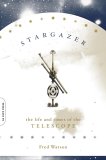Summary | Excerpt | Reviews | Beyond the Book | Readalikes | Genres & Themes | Author Bio

Critics' Opinion:
Readers' Opinion:
First Published:
Jul 2005, 360 pages
Paperback:
Jun 2006, 352 pages
 Book Reviewed by:
Book Reviewed by:
BookBrowse Review Team
Buy This Book
Of course, optical telescopes also predate all the other types
by more than 300 years. So perhaps it was not surprising that those attending
our forum paid little more than lip-service to the newer, 'invisible'
astronomies. There was a clear underlying message: at this meeting, optical
astronomy ruled, OK. Wavelength chauvinism was alive and well in Munich.
Then there was the obsession with size. Just why do optical
telescopes have to be so big?
Unlike Gary Larson's cartoon telescope, today's real telescopes
have at their heart a shallow, concave mirror to collect and focus the incoming
light. Bigger mirrors collect and concentrate more light, and an insatiable
appetite for light—even in very small quantities—is the most common dietary
complaint among astronomers. The more light that can be collected, the fainter
the objects that can be studied.
But there is another craving that draws astronomers towards ever
bigger telescope mirrors, one known as resolution—the fineness of the detail
that can be seen in a magnified image of the sky. The quest for resolution is as
old as the telescope itself, for it was the instrument's ability to reveal
invisible detail that made it such an astonishing invention in the first place.
Today, the physics of the situation is well understood: given the necessary
degree of optical perfection, the bigger the telescope mirror the finer the
detail it is capable of recording.
Like all dimensions in the sky, resolution is measured as an
angle. It is expressed in arcseconds—microscopic units that are to angles what
nanometres are to length. Geometry tells us that an arcsecond is 1/3600th of a
degree. So much for geometry; it's much more instructive to imagine a person 5
kilometres away holding up a coin. An Australian dollar, a British pound and a
US quarter are all about the right size. To your eye, the coin's diameter at
that distance is one arcsecond—and you would need a sizeable telescope to be
able to see it.
Putting some figures on resolution, a one-metre diameter
telescope mirror is theoretically capable of showing detail on a scale of a
little more than 0.1 arcseconds—the coin at 50 kilometres. But a 4 metre mirror
could resolve detail of one-quarter the size—0.03 arcseconds. That is fine
enough to detect surface markings on the planet Pluto, or the disc of the giant
star Betelgeuse. Bigger is definitely better.
Unfortunately, there is a wholly unwelcome natural phenomenon
that plays havoc with resolution, and that is atmospheric turbulence. We're all
familiar with what happens when a jet aircraft ploughs into turbulent air 10
kilometres or so above the ground. The nerve-racking shaking and juddering
happens even in cloudless skies. That same turbulence has an equally alarming
effect on rays of light coming down through the atmosphere. It gives the stars
their appealing twinkle when seen with the naked eye—but in the telescope, what
should be infinitesimally small points of light are blown up into fuzzy,
trembling balls.
Seeing the unseeable
What can be done about the problem of seeing? The direct
approach is to take your telescope above the atmosphere, but that is very
expensive. The Hubble Space Telescope, launched in 1990, was designed primarily
with this in mind (though its high-level vantage point also provided
unprecedented access to the ultraviolet waveband). The story of the Hubble, its
flawed 2.4 metre mirror and the 1993 rescue mission that enabled engineers to
recover most of its intrinsic resolution is well known, but less widely
appreciated is its cost. The eventual bill to build, launch and fix it was well
over US$2 billion (1990 dollars), and by the time the project is completed
sometime beyond 2010, it will have notched up more than US$6 billion.
From Stargazer by Fred Watson, pages viii - x of the Prologue, and pages 1-17 of Chapter 1. Copyright Fred Watson. All rights reserved. Excerpt reproduced by permission of Da Capo Press.





The Funeral Cryer by Wenyan Lu
Debut novelist Wenyan Lu brings us this witty yet profound story about one woman's midlife reawakening in contemporary rural China.
Your guide toexceptional books
BookBrowse seeks out and recommends the best in contemporary fiction and nonfiction—books that not only engage and entertain but also deepen our understanding of ourselves and the world around us.